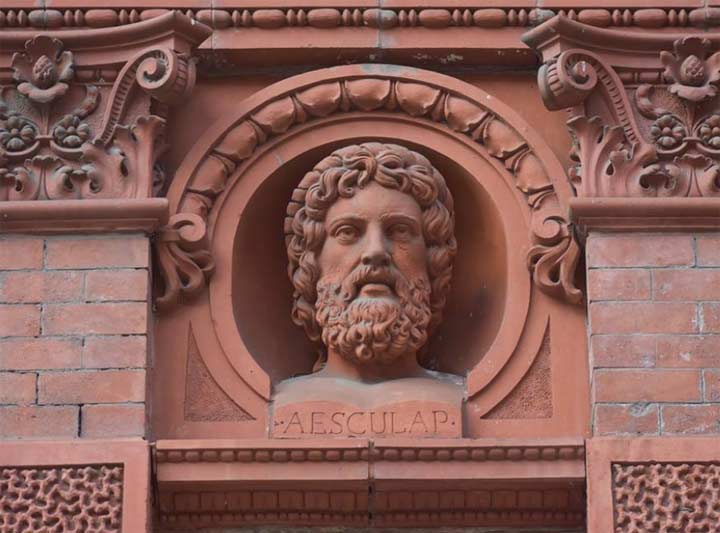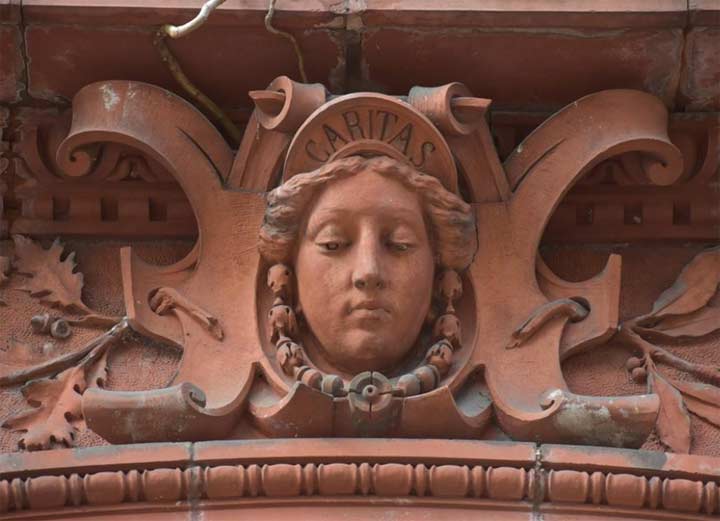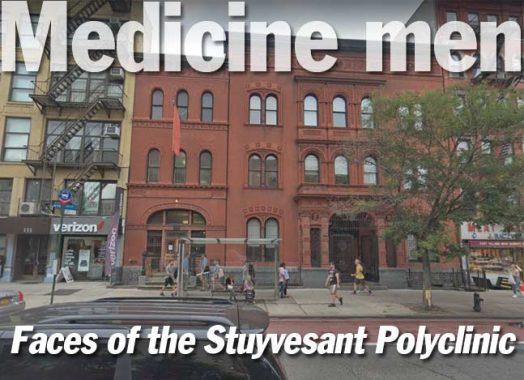Two deep-red brick buildings on the west side of 2nd north of St. Mark’s Place appear as if they were built at the same time and by the same architect and indeed both were designed by William Schickel and completed in 1884.
The Freie Bibliothek und Lesehalle (Free Library and Reading Room) and next door, the Stuyvesant Polyclinic, are both remnants of Kleindeutschland, the primarily German population that lived in the area in the late 1800s to early 1900s. The General Slocum steamboat disaster in 1904and America’s entry into World War I in 1917 both served to dissolve the clinic’s early German association, however, but the German inscription can still be seen over the library, now the Ottendorfer Branch of the NYPL. The Stuyvesant is no longer a medical office.
While an organization called the German Society had originally set up a clinic to care for the health needs of immigrant Germans in the 1850s that evolved into Lenox Hill Hospital, wealthy patrons Oswald and Anna Ottendorfer, made a considerable donation to the hospital and then decided to establish a new clinic downtown in Kleindeutschland, hiring architect William Schickel to design it as well as the smaller library next door. Schickel’s sumptuous red brick and terra cotta buildings, which were undertaken in 1883, still hold up marvelously.
Located on the roofline and the entrance on 2nd Avenue are the faces of physicians, allegorical figures and medical writers. I decided to list them here with a brief description of the reasons they’re commemorated…

Aesculapius was the Greco-Roman god of healing and medicine. While he originally may have commemorated a historical figure, the personality was eventually worshipped as a god and various stories arose about him; for example, he was supposedly taught the art of medicine by the wise centaur Chiron, and while mortal he was killed with one of Zeus’s thunderbolts for the heresy of circumventing his plans for man’s mortality.

The only woman depicted on the building, Caritas is an allegorical embodiment of charity. Though the Stuyvesant Polyclinic’s services were originally free of charge, they began demanding payment by the 1970s when the clinic was associated with the Cabrini Medical Center, which itself ended operations in 2007.
Anders Celsius (1701-1744) was a Swedish astronomer and physicist. He devised the temperature scale that bears his name (also known as the centigrade thermometer) in which water freezes at zero and boils at 100. It is the most popular worldwide thermometer. He also published geographical, astronomical and medicinal research papers.
Galen of Pergamum (129-216) was a highly influential Greek physician and researcher of the first and second centuries of the Common Era. He was an early proponent of dissection to research the body. Among his more important discoveries was the confirmation that the arteries carry blood, not air, as had been previously believed.
William Harvey (1578-1657) was the British physician who confirmed that blood circulates completely throughout the body.
Note the name of the sculptor, Löher, on the left side, which stands for German-born American sculptor Aloys Loeher (1850-1904).
The Greek physician Hippocrates (given as 460 BCE-375 BCE) is revered as the father of medicine in the ancient world. He was renowned for his ethical practices that are enumerated in the Hippocratic Oath.
Christoph Wilhelm Hufeland (1762-1836) was a prominent German physician. He was an advocate of homeopathy, or treating disease by natural means, and placed emphasis on treating the poor.
“Whether in the Amazonian forest or on the ridge of the high Andes, I was ever aware that one breath, from pole to pole, breathes one single life into stones, plants and animals and into the swelling breast of man.”
Alexander von Humboldt (1769-1859) was a German naturalist and geographer. He traveled widely in South America and Asia, and produced the five-volume work Cosmos, a study of the physical universe which was left unfinished at his death. Von Humboldt was also an abolitionist and favored independence for Spain’s South American colonies; a chance meeting with Simón Bolivar in Paris in 1804, it is said, helped inspire Bolivar’s subsequent revolutionary efforts.
He is also remembered by a heroic bust by Gustaf Blaeser at Central Park West and West 77th Street, and by Humboldt Street in Williamsburg and Greenpoint, Brooklyn.
Antoine-Laurent de Lavoisier (1743-1794) was a French scientist and researcher who is known as “the father of modern chemistry.” He researched and named oxygen and hydrogen, discovered oxygen’s role in combustion and respiration, and helped devise the widely-used metric system of measurement.
Carl von Linné, known as Carolus Linnaeus (1707-1778) was a Swedish botanist, physician, and zoologist whose best-known innovation was the nomenclature of living species, e.g. homo sapiens for Man.
Photos by Robert Mulero, the webmaster of Street Lights of New York City and the co-author of The History and Design of New York City Streetlights, Past and Present (2016, Dorrance).
Please help contribute to a new Forgotten NY website.
Check out the ForgottenBook, take a look at the gift shop, and as always, “comment…as you see fit.”
12/13/18
